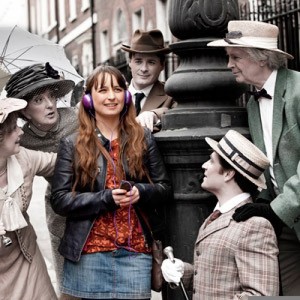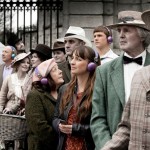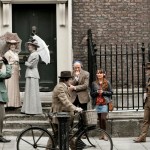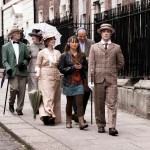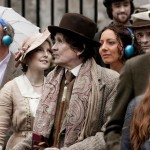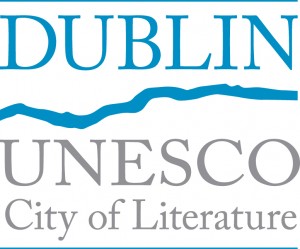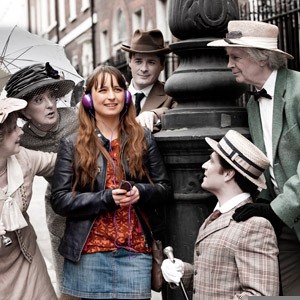Arminta Wallace, The Irish Times
“I felt that I had been very far away, in some land where the customs were strange – in Persia, I thought…” – The Sisters
I’m standing in the middle of Dublin, just north of the Liffey, at the corner of Parnell Street and Cumberland Street. The place is humming with cars, buses and people. Many – most – of the faces are African or Chinese. It’s already a potent mix of worlds. But as I prepare to cross the road I’m transported to a different world. Flickering all around me, in this other universe, are the sounds of James Joyce’s Dublin, from church bells to Victorian parlour songs. And inside my head are the rhythms and cadences of Joyce’s Dubliners.
The characters – Old Cotter, Ignatius Gallaher, Eveline Hill, Father Flynn and Gabriel Conroy – are speaking to me as if I’d just met them in one of the city’s many hostelries. It’s not so much that they have come out of the book as that I have strayed into it, courtesy of one of Wonderland Productions’ self-guided Dubliners walking tours.
“He pursued his reverie so ardently that he passed his street and had to turn back…” – A Little Cloud
Wandering around 21st-century Dublin, lost in Joyce, is a mildly perilous undertaking. The tour begins at the James Joyce Centre, on North Great George’s Street, where the staff kit you out with an MP3 player, headphones and a series of maps and charts. The player switches itself off regularly to save battery power, but it bookmarks the place, and restarts at the same point, so that isn’t a problem. The maps are crammed with visual information.
Perhaps wandering, Leopold Bloom-style, is a necessary part of the experience. And when you’re listening to beautifully written, beautifully performed stories through headphones, it’s easy to get lost.
“North Richmond Street, being blind, was a quiet street except at the hour when the Christian Brothers’ School set the boys free…” – Araby
There are several of these tours to choose from, depending on how much time you have. The route on the half-day tour takes you north from the Joyce centre past Belvedere College and Hardwicke Street, then up to the King’s Inns. Then it’s back along Capel Street and Mary Street to the river and Usher’s Island for the house of The Dead.
You track back via Temple Bar, Duke Street and Nassau Street. It takes about four hours, allowing pauses for coffee, lunch, standing and staring, sitting and dreaming. The commentary presents nuggets of information, tailored to the pace of your perambulation. Layers of history peel away from buildings as you pass.
The upper storey of Penneys on Mary Street fades to the Volta cinema, the scene of Joyce’s brief venture into the movie business. O’Neill’s pub on Suffolk Street becomes Corless’ restaurant. “Clifden oysters, wines from the wood and a first-class French chef.” And here is Joyce having tea with William Butler Yeats on Kildare Street. Yeats is 37, Joyce 20. “I’m sorry,” the younger writer remarks over his shoulder as he leaves, “but you’re too old for me to help you.”
“Da,” says the young man of Slavic extraction sitting next to me in a cafe on Mary Street as he and his friend tuck into two full Irish breakfasts. The sun blazes through the glass. The sunny side of the street. Joyce is meticulous about such things. You could check the forensic accuracy of his descriptive writing, if you were so inclined. Or you could just soak it up with the sunshine.
“Like distant music these words that he had written years before were borne towards him from the past…” – The Dead
The reading of The Dead is, unsurprisingly, the climax of the day. The story that almost didn’t make it into the collection has become a literary superstar.
But the overwhelming impression left by this tour is one of pulsating life. It’s a joyous celebration not just of Joyce but of parts of Dublin that many natives, never mind tourists, rarely see.
Like all good tours, it makes you look at your city with different eyes. Walking back down O’Connell Street to the James Joyce Centre, I pause at Middle Abbey Street while a Luas glides past. And then I do a double take. Cycling along behind the tram on an ancient sit-up-and-beg bike is a little auld lad straight out of Dubliners central casting.
I blink. Did I dream him? Is it some kind of visual Wonderland trick? No: there he is, pedalling merrily across O’Connell Street the wrong way, in the wake of the shiny new tram. Disappearing eastwards into the future. Joyce would love it.
Eithne Shortall, The Sunday Times
Lest anyone forget that the Irish capital belongs to James Joyce, Wonderland Productions has developed an audio performance of Dubliners, the author’s short story collection, that also acts as a city tour. Participants listen to adaptations of the tales on MP3 players (supplied) and follow the accompanying maps around Dublin.
The stories are performed well, with particularly enjoyable contributions from Barry Mc Govern and Shona Weymes, but it is not necessary to hear them on location. It is the additional, site-specific trivia that makes the trip worthwhile. The tour passes the National Library, where Joyce and WB Yeats met for tea in 1902, and wanders down Nassau Street where the author first gazed on Nora Barnacle, his future wife. The sign for Finn’s Hotel, where she worked, is still visible. An accomplished adaptation of The Dead is best enjoyed whilst wandering around the house on Usher’s Island where it is set. The eight hour tour is for a more fanatical Joycean than I, but picking your favourite bits from the half-day version is a treat for any fan. Bring a bike.
Kate O’Connor, QualityWaffle.ie
Joyce said of Ulysses, ‘I want to give a picture of Dublin so complete that if the city one day suddenly disappeared from the earth it could be reconstructed out of my book’, however the same could be said of his collection of short stories Dubliners.
A collection of 15 beautifully constructed short stories; Dubliners dips gently into the lives of a host of characters living in Dublin city around the beginning of the twentieth century. Even though Joyce wrote most of his work whilst living outside of Ireland, Dublin is perhaps one of his biggest and most influential characters in his work. Which is why it is a mecca for lovers of Joyce’s work, who come every year to explore the city that inspired one of the world’s greatest writers.
All this has led theatre producer Alice Coughlan [sic] to down her theatre tools and assemble quite a large cast of inspirationally-voiced actors, whom she recorded reading various selections of text from a number of different stories in Dubliners. What results is a tiny little mp3 player, which holds some beautiful recordings of these fabulous stories. However, Wonderland Productions’ Dubliners Walking Experience is not just about the recordings, it involves a map and the city of Dublin also. Slipping on your headphones and heading out onto these historical streets, you are immersed deep into each story.
To really make the experience effective, Coughlan has reworded and restructured some of the work to include more dialogue in each story, so that the characters can tell their stories more than the narratorial voice originally in the story. Two Gallants in particular is very striking, walking down Rutland Square (known to today’s Dubliner as Parnell Square East), we earwig on Lenehan and Corley discussing the generosity Corley has managed to receive from a certain lady friend.
The highlight for me was The Dead – the most striking story in the collection, it has its home in Usher’s Island and also The Gresham. While The Gresham piece wasn’t as poignant as it could have been due to the ridiculous amount of Dublin buses crawling by, the house on Usher’s Island was particularly special. Entering the house, you sit and listen to Lily the Caretaker being literally rushed off her feet and Gabriel making his entrance, peeling off his galoshes. Climbing up the stairs, we enter the drawing room and hear the wonderful music and conversation. We find the dining room is set for dinner and take our place at the table to listen to the dinner conversation. Arriving back downstairs, we gaze up the stairs as The Lass of Aughrim floats through the air – if there was anything that ironically could bring The Dead to life, it was this moment.
Various other stories are mapped out, with stops scattered across the city – the Church on Meath Street, Temple Bar, Ely Place, St. Stephen’s Green – they’re all packed in there in a half day tour that took us near on five hours to complete. There’s a full day tour available also which takes you out to Chapelizod as well as the city centre. The tour was extremely impressive, not just by how well the extracts have been delicately reworked in parts, and carefully recorded, but also by how well they bring the stories to life when listened to on site. It may perhaps be a bit too long for someone who isn’t entirely head over heels in love with Joyce, perhaps a shortened version taking about two hours long would be a more attractive activity, but for anyone who loves Joyce and would like to experience his work being really and truly brought to life, then it’s a must.
Sara Keating, The Sunday Business Post
From the distance of his various homes in Trieste, Zurich, and Paris, James Joyce recreated a map of his home city through his fiction. In Ulysses and Finnegans Wake his tribute to Dublin is an expressionistic one, reimagining the geography of the city’s streets through the subconscious mind. In Dubliners, however, his affection for Dublin is more easily accessible, in a series of short-stories that provide intimate encounters with the city’s inhabitants in the early twentieth century.
Wonderland Productions has married Joyce’s work with its topographical spirit in James Joyce’s Dubliners, an audio-tour that combines geographical detail with dramatised versions of the stories, the tour begins when participants are given a MP3 player and a slim plastic envelope containing maps and instructions. There are a variety of options available for the participant: a two and an half hour mini tour, a half day tour, and a full day tour. The tour can be condensed by taking a bicycle rather than walking and there are suggestions for refreshment stops, some of which can even be integrated into the storytelling, which is of course the focus of this audio-theatrical production.
Adapted and directed by Alice Coghlan, Joyce’s stories are presented as first-person narrations or dialogic scenes. Where audio versions of short stories are often read by a single reader, here the use of different voices helps enormously in creating the intimacy of evoked atmospheres. The Sisters, for example, is narrated by a child, and the authorial voice disappears so that the story can become pure character…
The walking tour, meanwhile, remembers the writer’s school days at Belvedere College, Finn’s Hotel where his future wife Nora Barnacle worked and his aunts’ house on Usher’s Island where the central story of Dubliners, The Dead, is set. A tourist will undoubtedly experience these sites differently from a native, but there are surprises even for those who know Joyce’s city centre haunts well. The nature of an audio tour is that it guides your vision. I have never noticed the gates at Kings Inn, though I lived close by when I was in college. I had never seen the grotto behind St Catherine’s on Meath Street, though my father was christened there.
Dubliners: An Audio Tour is a terrific idea, well executed, and one that might easily be replicated to provide dramatised access to the life and writings of other Irish writers. However, it is difficult to think of a writer whose work would suit the format more than Joyce.
Entertainment.ie
2012 is a monumental year for fans of the iconic Irish writer James Joyce, not to mention the arts world as a whole. There is something about Joyce’s work, specifically the much-loved Dubliners, that lends itself to the stage, and thus there are many in the theatre world who find themselves in a tizzy of excitement with the news that this year his work finally comes out of copyright and is open to interpretation, re-working and of course dramatization. Wonderland’s Alice Coghlan is one such person, and with her company’s audio walking tour of Dublin, has intentions to revive the Dublin in which Joyce’s characters walked, lived, loved and lost in his 1914 collection of short stories, Dubliners.
In the year that Dubliners has been chosen as Dublin City Library’s “One City, One Book”, Wonderland gives you the opportunity to follow the footsteps of Joyce’s eclectic host of characters while listening to their voices and stories acted out by a sizeable cast via mp3 players. Whether you are a Joyce fanatic, someone whose head has been turned by the hype surrounding his work in this significant year, or, perish the thought, feel ill at the sight of Ulysses perched pretentiously on any self-respecting scholar’s coffee table, walking the streets of Joyce’s Dublin has a transporting effect that stays with you long after the Mp3 and giant earphones have been returned.
That’s not to say this is a perfectly devised piece. While one appreciates the value in retracing the steps of the people who populated Dubliners and the Dublin of 1914, there is something mildly disconcerting about being instructed to walk around in circles in some less than savoury areas of the city. Although the juxtaposition of Dublin then and now is undisputedly interesting, there was something about the ginormous earphones and maps that seemed to yell “Rob me, rob me” as we walked Parnell St and Hardwicke street, the locations of The Boarding House. It takes the first couple of stories to abandon any trepidation and lose oneself in the voices and sounds of Dublin 100 years ago, but by the time we had arrived at Henrietta Street for the recitation of A Little Cloud it was easy to do so and enjoy the experience immensely.
The Dubliners walking tour is a wonderfully conceived idea, and although there are some small problems concerning the ease of navigation (both with the map and the mp3 player) there are a handful of moments throughout the course of the adventure which overshadow them. The recreation of the dinner party in The Dead is atmospherically executed – the candlelit dining room table conjuring up images of dancing, quarrels and, of course, the heart-breaking unrequited love that lies at the heart of this story. Another stand out moment was a stop off at Farrington’s in Temple Bar, a pub which features in Counterparts and retains its charm from that time, even if the barman did seem confused and slightly afraid when, as instructed in the programme, we quizzed him on the pub’s literary connections.
This walking tour will bring you to corners of Dublin that do not feature highly on the tourist trail and is all the better for it. As soon as you get into your stride and immerse yourself in the interwoven stories of the Dubliners of long ago, it becomes almost a thrill to walk in the path of these curious characters and, of course, the man who gave them life. I can’t think of a much better way to celebrate this monumental year for James Joyce, or indeed to spend a sunny Saturday in our fair city.”
Dave Madden, DublinCulture.ie
It’s a self guided audiotour; the participant dons a pair of headphone with an attached iPod, and is guided around with the help of an accompanying map. The tour starts at the Dublin Writers Museum on Parnell Square (beside the excellent Chapter One restaurant) and meanders through the city centre to locations featured in Dubliners.
There are two main types of material on the audiotour. For the most part it consists of abridged audio versions of the stories from the book. The voice-acting is good and the concept of walking around the locations while hearing the corresponding stories works well, although unavoidably the length of each story and the time it takes to walk the real-world setting do not always match. Just keep walking and don’t let it bother you, I’d suggest.
The headphones do a good job of insulating the listener from the noise of the 21st century city, creating a strange sensation of not really being in the modern-day city. As someone living in Dublin I found the tour interesting as an insight into the city a century ago; to see which areas are still run down (many of them) and which have changed (a few, not always for the better). Helpfully, as well as stories and directions the audio also provides ‘extras’ – comments on Dublin and Joyce.
Henrietta Street, leading up to King’s Inns on Constitution Hill, and featured in the story A Little Cloud, is one of the most changed. A once well to do area, it’s now bleak and decrepit. From there you’ll be lead down Capel Street, and along the Quays towards James Joyce Bridge and the ‘House of The Dead’, the location for the final story of Dubliners, The Dead. Wonderland have temporarily opened the building up to the public so if you’re a fan of Joyce get down there while you can and enjoy being in the location of one of Joyce’s main stories.
Back to Dubliners’ Production Details Read More Wonderland Reviews






